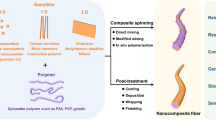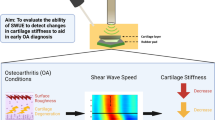Abstract
Transmission electron micrographs of fully mineralized turkey leg tendon in cross-section show the ultrastructure to be more complex than has been previously described. The mineral is divided into two regions. Needlelike-appearing crystallites fill the extrafibrillar volume whereas only platelike crystallites are found within the fibrils. When the speciment is tilted through a large angle, some of the needlelike-appearing crystallites are replaced by platelets, suggesting that the needlelike crystallites are platelets viewed on edge. If so, these platelets have their broad face roughly parallel to the fibril surface and thereby the fibril axis, where the intrafibrillar platelets are steeply inclined to the fibril axis. The projection of the intrafibrillar platelets is perpendicular to the fibril axis. The extrafibrillar volume is at least 60% of the total, the fibrils occupying 40%. More of the mineral appears to be extrafibrillar than within the fibrils. Micrographs of the mineralized tendon in thickness show both needlelike-appearing and platelet crystallites. Stereoscopic views show that the needlelike-appearing crystallites do not have a preferred orientation. From the two-dimensional Fourier transform of a selected area of the cross-sectional image, the platelike crystallites have an average dimension of 58 nm. The needlelike-appearing crystallites have an average thickness of 7 nm. The maximum length is at least 90 nm. Atomic force microscopy (AFM) of unstained, unmineralized turkey leg tendon shows collagen fibrils very much like shadow replicas of collagen in electron micrographs. AFM images of the mineralized tendon show only an occasional fibril. Mineral crystallites are not visible. Because the collagen is within the fibrils, the extrafibrillar mineral must be embedded in noncollagenous organic matter. When the tissue is demineralized, the collagen fibrils are exposed. The structure as revealed by the two modalities is a composite material in which each component is itself a composite. Determination of the properties of the mineralized tendon from the properties of its elements is more difficult than considering the tendon to be just mineral-filled collagen.
Similar content being viewed by others
References
Lee DD, Glimcher MJ (1991) Three-dimensional spatial relationship between the collagen fibrils and the inorganic calcium phosphate crystals of pickerel and herring bone. J Mol Biol 217: 487–501
Traub W, Arad T, Weiner S (1989) Three-dimensional ordered distribution of crystals in turkey tendon leg collagen fibers. Proc Natl Acad Sci USA 86: 9822–9826
Landis WJ, Moradian-Oldak J, Weiner S (1991) Topographic imaging of mineral and collagen in the calcifying turkey tendon. Connect. Tissue Res 25: 181–196
Landis WJ, Song MJ (1991) Early mineral deposition in calcifying tendon characterized by high voltage electron microscopy and three-dimensional graphic imaging. J Struct Biol 107: 116–127
Arsenault AL, Frankland BW, Ottensmeyer FP (1991) Vectorial sequence of mineralization in the turkey leg tendon determined by electron microscopy imaging. Calcif Tissue Int 48: 46–55
Katz EP, Wachtel E, Yamauchi M, Mechanic GL (1989) The structure of mineralized collagen fibrils. Connect Tissue Res 21: 149–158
Weiner S, Traub W (1991) Organization of crystals in bone. In: Saga S, Nakahara H (eds) mechanisms and phylogeny of mineralization in biological systems. Springer Verlag, Tokyo, pp
Landis WJ (in press) Mineral and organic matrix interaction in normally calcifying tendon visualized in 3 dimensions by high voltage electron microscopic tomography and graphic image reconstruction. J Struct Biol
Fratzl P (1992) Mineral crystallites in calcified tissues: a comparative study by SAXS. J Bone Miner Res 7: 329–334
Weiner S, Price PA (1986) Disaggregation of bone into crystals. Calcif Tissue Int 39: 365–375
Eanes ED, Lundy DR, Martin GN (1970) X-ray diffraction study of the mineralization of turkey leg tendon. Calcif Tissue Res 6: 239–248
Eanes DR, Martin GN, Lundy DR (1976) The distribution of water in turkey leg tendon. Calcif Tissue Res 20: 313–316
Bigi A, Riamonte A, Koch MHJ, Roveri N (1988) Calcified turkey leg tendon as structural model for bone mineralization. Int J Biol Macromol 10: 282–286
Lees S, Bonar LC, Mook HA (1984) A study of dense mineralized tissues by neutron diffraction. Int J Biol Macromol 6: 321–326
Lees S (1986) Water content in type I collagen tissues calculated from the generalized packing model Int J Biol Macromol 8: 65–72
Lees S, Page EA (1992) A study of some properties of mineralized turkey leg tendon. Connect Tissue Res 28: 263–287
McEwen BF, Song MJ, Landis WJ (1991) Quantitative determination of the mineral distribution in different collagen zones of calcifying tendon using high voltage electron microscopic tomography. J Comput Assist Microsc 3: 201–210
Arsenault AL () Image Analysis of collagen-associated mineral distribution in cryogenically prepared turkey leg tendons. Calcif Tissue Int 48: 56–62
Lees S, Prostak K (1988) The locus of mineral crystallites in bone. Connect Tissue Res 18: 41–54
Sasaki N, Ikawa T, Fukada A (1991) Orientation of mineral in bovine bone and the anisotropic mechanical properties of plexiform bone. J Biomech 24:57–61
Burstein AH, Jocelyn MZ, Kingsbury GH, Klein L (1975) Contribution of collagen and mineral to the elastic-plastic properties of bone. J Bone Jt Surg 57A: 956–961
Wagner HD, Weiner S (1992) On the relationship between the microstructure of bone and its mechanical stiffness. J Biomech 25: 1311–1320
Traub W, Arad T, Weiner S (1989) Three-dimensional ordered distribution of crystals in turkey leg tendon fibers. Proc Natl Acad Sci USA 86: 9822–9826
Mammone JF, Hudson SM (1993) Micromechanics of bone strength and fracture. J Biomech 26: 439–446
Author information
Authors and Affiliations
Rights and permissions
About this article
Cite this article
Lees, S., Prostak, K.S., Ingle, V.K. et al. The loci of mineral in turkey leg tendon as seen by atomic force microscope and electron microscopy. Calcif Tissue Int 55, 180–189 (1994). https://doi.org/10.1007/BF00425873
Received:
Accepted:
Issue Date:
DOI: https://doi.org/10.1007/BF00425873




